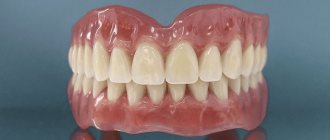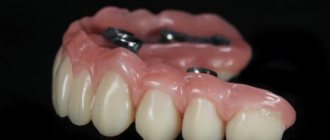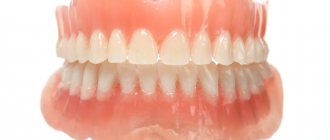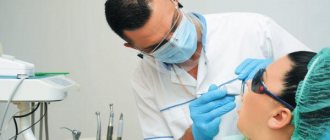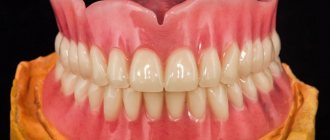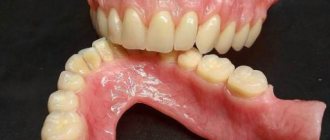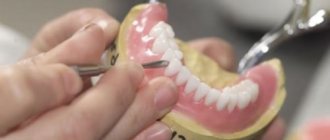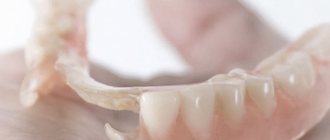Complete edentia is characterized by the absence of all teeth - in one or both rows. The solution to the problem can be removable prosthetics or implantation. The second method is more comfortable, aesthetically pleasing and durable in the long term. However, removable dentures also cannot be discounted - with complete edentia, this is the most economical option for prosthetics. In addition, this is the only solution for patients with contraindications to surgery.
With complete edentia, removable dentures are fixed mainly on the gums. They “stick” to the soft mucous membranes and adhere tightly to them. It is due to this that the structure is retained in the mouth. Towards the end of its service life, the structure will stretch a little and will be held less reliably - special dental glue will solve the problem.
Possibilities of removable dentures in the absence of all teeth
If there are no teeth left, the patient may be offered the choice of the following removable dentures:
- plate acrylic dentures : the most inexpensive option, which is created from hard plastic. Such structures adhere rather poorly to the gums, they are massive and often rub the mucous membranes. But the Smile-at-Once clinic uses new generation acrylic with the addition of diamond chips. Such dentures are distinguished by good aesthetics, a tight fit to the gums and increased wear resistance.
- prostheses made of elastic plastics : this category includes structures made from soft and elastic plastics. They fit snugly to the gums, are securely held in the mouth and have a fairly natural appearance. This category includes nylon and Acry Free (Acry Free)
- A separate category for almost complete loss of teeth also consists of removable dentures with locks. But to fix them, at least two living tooth roots are required on which such a prosthesis will be attached.
- nylon prostheses not used at the Smile-at-Once clinic . Just over 10 years ago, they were a real revolution in the field of removable prosthetics - compared to plate ones, they were more comfortable. However, in practice it has been proven that such dentures, due to the increased elasticity of the material, stretch greatly after 1-2 years, which means they do not adhere well to the gums (especially on the lower jaw), require frequent adjustments (relining) and cause pain while eating . In addition, due to elasticity and uneven pressure, they lead to acute bone atrophy and reduction in the volume of the alveolar ridge.
- removable dentures on implants are the best and most comfortable option for removable dentures; they do not pop out on the lower jaw and do not have a palate, like previous options for replacing teeth on the upper jaw, which blocks the taste buds and can cause a gag reflex. They are securely fixed in the oral cavity due to the presence of a support at least 4 points and a beam connecting the implants, onto which they snap. Their disadvantage is the cost, which today is almost equal to alternative solutions for fixed prosthetics on implants, for example All on 4 or All on 6 with screw fastening.
Complete dental prosthetics
In the classical sense, complete jaw prosthetics implies the presence of complete edentia, that is, when not a single tooth remains. Fixation of the prosthesis in the absence of teeth is carried out using implants or special suction cups located on the base of the removable denture.
Dental prosthetics in cases of complete absence of teeth are divided into three large categories.
- Removable dentures can be removed without assistance.
- Fixed - installed with support on dental implants.
- Conditionally removable - removed using professional tools by a dentist.
Clasp apparatus
Experts are confident that the only thing better than a removable structure for the upper or lower jaw is a fixed analog or clasp denture. The latter option is recommended for use in case of partial loss of teeth. It is based on a metal frame and is fixed on the supporting elements of the row.
It is distinguished by its compact size, which guarantees a high degree of comfort. The product rests on a thin metal arc. It is secured with clasps (hooks), attachments (micro-locks), and telescopic crowns. This model is more expensive, but its price is quite reasonable.
Types of complete dental prosthetics
Implantation today is an advanced method of restoring teeth, including those with complete edentia. Purely theoretically, it is possible to replace every lost tooth with implants, but such a procedure will cost enormous amounts of money, which in general is not entirely justified. Specifically for the diagnosis of complete edentia, clinicians have developed a number of concepts that allow the installation of a fixed prosthesis on a certain number of implants. Complete prosthetics of the upper jaw more often require osteoplastic surgery (compared to the lower jaw), since the bone here is less dense and voluminous.
Complete fixed dental prosthetics
All-on-4 (all on four)
Concepts of complete fixed dental prosthetics on 4 implants. The technique was developed by a well-known manufacturer of implantation systems - Nobel Biocare.
All-on-6 (all on six)
Method of complete fixed dental prosthetics using 6 implants. Considered a more reliable option than All-on-4.
Complete mandibular prosthesis Trefoil
The Trefoil concept is also from Nobel Biocare. The technique involves the use of only three implants and a special beam platform. However, the technology is used only when it is necessary to carry out complete prosthetics of the lower jaw. Due to anatomical features, upper dentures with complete absence of teeth must rest on at least four implants.
ReSmile
"ReSmile®" is a comprehensive solution for restoring chewing function in cases of complete absence of teeth and severe lack of bone tissue. The concept involves the restoration of all teeth with a complete fixed prosthesis on cement or screw fixation (14-16 teeth) with the rapid restoration of all functions of the jaw (chewing, swallowing and others), as it is carried out without incisions in the gums by puncture. Re-prosthetics are not required with this method.
ATTENTION!
As a temporary option for more reliable fixation of the prosthesis, mini-implants can be used. They are easy to install and do not require large amounts of bone.
Prosthetics with complete removable dentures
The option of fixed prosthetics is only possible with the installation of intraosseous dental implants. If this is not feasible, it makes sense to pay attention to removable prosthetics. These are products with a soft base and artificial teeth that copy the gums and the visible (crown) part of the teeth.
Acrylic
Prostheses made from special plastic. Suitable for complete prosthetics of the lower jaw and upper jaw due to good load distribution. Dentures are uncomfortable, promote the accumulation of bacteria, and the material itself can cause allergies.
Nylon
Good fixation, moisture resistance, hypoallergenicity and comfort are the qualities that make nylon prostheses worth paying attention to. On the other hand, they distribute pressure worse when chewing and sag over time (the bone tissue under such a prosthesis atrophies faster).
The best removable dentures for complete absence of teeth should be hypoallergenic, distribute the load well and not cause serious discomfort when worn.
Stages
1 Consultation, diagnostics
2 Preparation
3 Surgery
4 Orthopedics
The doctor will visually examine your teeth and gums to make an initial assessment of their health. He will collect anamnesis, conduct a hardware examination (orthopantomogram + computed tomography), and make sure that there are no contraindications to prosthetics on implants.
Plaque and stone are removed, diseased teeth on the antagonist jaw (if there are teeth) are treated. The implant dentist prepares a treatment plan, incl. 3D model of the jaw for detailed planning of the operation. A date for the operation is set and a contract is concluded.
An injection of local anesthesia is administered. Four or six implants are installed depending on the technology used for prosthetics of a toothless jaw.
On days 3-7 after installation of the implants, a temporary (adaptation) prosthesis is fixed on them. At the end of the period of osseointegration of the artificial roots, a permanent prosthesis is placed.
The best dentures for complete absence of teeth
Many patients ask the question, which dentures are better for complete absence of teeth? On the one hand, the answer here is obvious. The best dentures for complete absence of teeth are placed on implants. It is titanium roots that prevent bone tissue loss, provide the necessary stability of the structure, distribute the chewing load as efficiently as possible and allow you to achieve good aesthetics. However, implantation cannot be performed in all cases, since the procedure has a list of contraindications and is not cheap. The cost of complete dental prosthetics can cost more than half a million rubles, and this is far from the limit. The Trefoil concept will be cheaper, but it has a significant limitation (it is impossible to carry out complete prosthetics of the upper jaw teeth).
Features of treatment
The most common questions from patients are answered by an implantologist at the InWhite Medical clinic.
How do you prepare for implantation?
You undergo basic tests to exclude contraindications for implantation, undergo a computed tomography scan - the doctor receives a 3D image that shows the entire structure of the jaw: bone, soft tissue, blood vessels, nerves. It is necessary for accurate planning of implant installation and creation of a surgical template.
Is it really necessary to live without teeth for another 4-6 months after implantation?
Of course not! For the entire period of osseointegration, you will be fitted with a temporary prosthesis - it is lightweight, does not load the implants, but looks aesthetically pleasing.
How are dentures made?
We manufacture ceramic and zirconium prostheses using high-precision CAD/CAM equipment; each crown in the prosthesis is processed manually by a technician - applying shadows and fissures. As a result, no one will distinguish your new teeth from real ones even at close range.
How to care for fixed dentures?
Hygiene is a little more difficult compared to removable structures. It is necessary not only to brush your teeth thoroughly, but also to use an irrigator and rinsers for implants to clean bacterial plaque from all artificial surfaces. Visit our clinic every 6 months for a professional cleaning.
If you follow our recommendations, a fixed prosthesis will last you a long time. Come to our clinic, we will select the best treatment option for edentulousness and together we will enjoy your new smile.
How to care for removable dentures?
The most important rule is good oral hygiene, and then there is no risk of damage to the denture or inflammatory processes in the oral cavity. Caring for dentures is simple and does not take much time:
- Brush with a toothbrush at least 2 times a day.
- Wash with warm water (no more than 40 degrees).
- Dry on a soft-lint towel; it is advisable not to blot or wipe, so as not to put pressure on the base of the prosthesis.
- Disinfect twice a day with a special product. In some cases, you can soak the denture in a disinfectant overnight.
- Once every six months – preventive cleaning of the prosthesis.
Which material is better and will last longer?
The degree of reliability of fixation, comfort and aesthetics during use depends on the material from which removable dentures are made.
The main requirements for them include:
- strength;
- biocompatibility with human tissues;
- lack of toxicity, allergenicity, effects on taste and olfactory receptors.
Acrylic is the most popular and affordable material. It does not change its properties over time; acrylic dentures have good aesthetics. But it has a porous structure and can accumulate bacteria that cause inflammation.
Nylon is a lightweight and flexible material. Does not cause an allergic reaction and does not accumulate bacteria. Although it is durable, due to its softness and elasticity it quickly becomes unusable, so nylon dentures perform a good aesthetic function, but do not cope well with their intended purpose, chewing.
Acry Free is a modern material for removable dentures (translucent plastic that does not contain acrylic). It is elastic, does not injure the mucous membrane, and structures made from it are resistant to mechanical stress. This material is suitable for patients with allergies to metal or acrylic and with hypertonicity of the masticatory muscles. The service life of dentures made from it is longer than that of acrylic ones. The cost is higher than acrylic and lower than nylon and clasp.
How dangerous is tooth loss, what consequences can it lead to?
When a tooth is lost, the integrity of the dentition is compromised and this phenomenon is unpleasant not only because it affects the aesthetics of the smile, but also because it creates a number of serious problems with the overall health of the body. The consequences of adentia, which is not eliminated in a timely manner by prosthetics, can be as follows:
- Gradual displacement of adjacent dental units in a row, leading to their deformation;
- Excessive load on teeth, leading to their rapid destruction;
- Increased risk of developing various gum and periodontal diseases;
- Single adentia can also provoke the appearance of malocclusion.
The loss of even one tooth in a row disrupts the correct processes of chewing food, and this can lead to disturbances in the functioning of the gastrointestinal tract. Against the background of this phenomenon, various chronic pathologies are actively developing, the treatment of which can be a long and difficult process.
For these reasons, you should contact a dentist for dental prosthetics not only when there is a loss of a tooth included in the smile area, but also in the event of loss of a masticatory unit.
Price
- Primary appointment (examination, consultation) with a dentist (special offer) 100001
For free
Promotion
- Tooth restoration with inlay (E.max) 152012
19 900 ₽
- Tooth restoration with a crown (E.max) 152013
21 900 ₽
- Tooth restoration with Veneer, Half-crown (E.max) 152014
21 900 ₽
- Tooth restoration with a full zirconium crown 152015
13 900 ₽
- Prosthetics with partial removable lamellar dentures (up to 3 teeth) 153001
9 900 ₽
- SGS implant + turnkey crown
24 900 ₽
Promotion
Prosthetics of one tooth is carried out to restore its anatomy and functions in case of destruction or loss. The replacement method is selected taking into account the clinical situation and patient preferences. Implantation is recognized as the most physiological method of single restoration. The procedure allows you to restore the functions of the lost root and crown. The artificial tooth functions and feels like the patient’s own.
